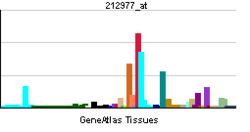ACKR3
| View/Edit Human | View/Edit Mouse |
Atypical chemokine receptor 3 also known as C-X-C chemokine receptor type 7 (CXCR-7) and G-protein coupled receptor 159 (GPR159) is a protein that in humans is encoded by the ACKR3 gene.[4][5]
This gene encodes a member of the G protein-coupled receptor family. This protein was earlier thought to be a receptor for vasoactive intestinal peptide (VIP) and was considered to be an orphan receptor. It is now classified as a chemokine receptor able to bind the chemokines CXCL12/SDF-1 and CXCL11. The protein is also a coreceptor for human immunodeficiency viruses (HIV). Translocations involving this gene and HMGA2 on chromosome 12 have been observed in lipomas. Alternatively spliced transcript variants encoding the same protein isoform have been found for this gene. Whereas some reports claim that the receptor induces signaling following ligand binding, recent findings in zebrafish suggest that CXCR7 functions primarily by sequestering the chemokine CXCL12.[5]
However, another recent study has provided evidence that ligand binding to CXCR7 activates MAP kinases through Beta-arrestins, and thus has functions beyond ligand sequestration.[6]
References
- ↑ "Drugs that physically interact with Atypical chemokine receptor 3 view/edit references on wikidata".
- ↑ "Human PubMed Reference:".
- ↑ "Mouse PubMed Reference:".
- ↑ Balabanian K, Lagane B, Infantino S, Chow KY, Harriague J, Moepps B, Arenzana-Seisdedos F, Thelen M, Bachelerie F (October 2005). "The chemokine SDF-1/CXCL12 binds to and signals through the orphan receptor RDC1 in T lymphocytes". The Journal of Biological Chemistry. 280 (42): 35760–6. doi:10.1074/jbc.M508234200. PMID 16107333.
- 1 2 "Entrez Gene: CXCR7 chemokine (C-X-C motif) receptor 7".
- ↑
- Rajagopal S, Kim J, Ahn S, Craig S, Lam CM, Gerard NP, Gerard C, Lefkowitz RJ (January 2010). "Beta-arrestin- but not G protein-mediated signaling by the "decoy" receptor CXCR7". Proceedings of the National Academy of Sciences of the United States of America. 107 (2): 628–32. doi:10.1073/pnas.0912852107. PMC 2818968
 . PMID 20018651.
. PMID 20018651.
- Rajagopal S, Kim J, Ahn S, Craig S, Lam CM, Gerard NP, Gerard C, Lefkowitz RJ (January 2010). "Beta-arrestin- but not G protein-mediated signaling by the "decoy" receptor CXCR7". Proceedings of the National Academy of Sciences of the United States of America. 107 (2): 628–32. doi:10.1073/pnas.0912852107. PMC 2818968
Further reading
- Nagata S, Ishihara T, Robberecht P, Libert F, Parmentier M, Christophe J, Vassart G (March 1992). "RDC1 may not be VIP receptor". Trends in Pharmacological Sciences. 13 (3): 102–3. doi:10.1016/0165-6147(92)90037-7. PMID 1315461.
- Libert F, Passage E, Parmentier M, Simons MJ, Vassart G, Mattei MG (September 1991). "Chromosomal mapping of A1 and A2 adenosine receptors, VIP receptor, and a new subtype of serotonin receptor". Genomics. 11 (1): 225–7. doi:10.1016/0888-7543(91)90125-X. PMID 1662665.
- Sreedharan SP, Robichon A, Peterson KE, Goetzl EJ (June 1991). "Cloning and expression of the human vasoactive intestinal peptide receptor". Proceedings of the National Academy of Sciences of the United States of America. 88 (11): 4986–90. doi:10.1073/pnas.88.11.4986. PMC 51792
 . PMID 1675791.
. PMID 1675791. - Law NM, Rosenzweig SA (May 1994). "Characterization of the G-protein linked orphan receptor GPRN1/RDC1". Biochemical and Biophysical Research Communications. 201 (1): 458–65. doi:10.1006/bbrc.1994.1723. PMID 8198609.
- Shimizu N, Soda Y, Kanbe K, Liu HY, Mukai R, Kitamura T, Hoshino H (January 2000). "A putative G protein-coupled receptor, RDC1, is a novel coreceptor for human and simian immunodeficiency viruses". Journal of Virology. 74 (2): 619–26. doi:10.1128/JVI.74.2.619-626.2000. PMC 111581
 . PMID 10623723.
. PMID 10623723. - Broberg K, Zhang M, Strömbeck B, Isaksson M, Nilsson M, Mertens F, Mandahl N, Panagopoulos I (August 2002). "Fusion of RDC1 with HMGA2 in lipomas as the result of chromosome aberrations involving 2q35-37 and 12q13-15". International Journal of Oncology. 21 (2): 321–6. doi:10.3892/ijo.21.2.321. PMID 12118328.
- Infantino S, Moepps B, Thelen M (February 2006). "Expression and regulation of the orphan receptor RDC1 and its putative ligand in human dendritic and B cells". Journal of Immunology. 176 (4): 2197–207. doi:10.4049/jimmunol.176.4.2197. PMID 16455976.
- Burns JM, Summers BC, Wang Y, Melikian A, Berahovich R, Miao Z, Penfold ME, Sunshine MJ, Littman DR, Kuo CJ, Wei K, McMaster BE, Wright K, Howard MC, Schall TJ (September 2006). "A novel chemokine receptor for SDF-1 and I-TAC involved in cell survival, cell adhesion, and tumor development". The Journal of Experimental Medicine. 203 (9): 2201–13. doi:10.1084/jem.20052144. PMC 2118398
 . PMID 16940167.
. PMID 16940167. - Proost P, Mortier A, Loos T, Vandercappellen J, Gouwy M, Ronsse I, Schutyser E, Put W, Parmentier M, Struyf S, Van Damme J (July 2007). "Proteolytic processing of CXCL11 by CD13/aminopeptidase N impairs CXCR3 and CXCR7 binding and signaling and reduces lymphocyte and endothelial cell migration". Blood. 110 (1): 37–44. doi:10.1182/blood-2006-10-049072. PMID 17363734.
- Miao Z, Luker KE, Summers BC, Berahovich R, Bhojani MS, Rehemtulla A, Kleer CG, Essner JJ, Nasevicius A, Luker GD, Howard MC, Schall TJ (October 2007). "CXCR7 (RDC1) promotes breast and lung tumor growth in vivo and is expressed on tumor-associated vasculature". Proceedings of the National Academy of Sciences of the United States of America. 104 (40): 15735–40. doi:10.1073/pnas.0610444104. PMC 1994579
 . PMID 17898181.
. PMID 17898181. - Wang J, Shiozawa Y, Wang J, Wang Y, Jung Y, Pienta KJ, Mehra R, Loberg R, Taichman RS (February 2008). "The role of CXCR7/RDC1 as a chemokine receptor for CXCL12/SDF-1 in prostate cancer". The Journal of Biological Chemistry. 283 (7): 4283–94. doi:10.1074/jbc.M707465200. PMID 18057003.
- Boldajipour B, Mahabaleshwar H, Kardash E, Reichman-Fried M, Blaser H, Minina S, Wilson D, Xu Q, Raz E (February 2008). "Control of chemokine-guided cell migration by ligand sequestration". Cell. 132 (3): 463–73. doi:10.1016/j.cell.2007.12.034. PMID 18267076.
This article incorporates text from the United States National Library of Medicine, which is in the public domain.
